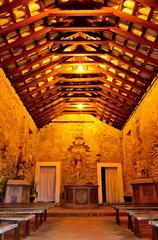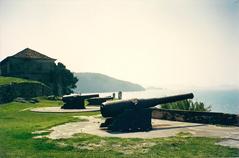Fort of Our Lady of the Conception of the Lagoon: Visiting Hours, Tickets, and Historical Significance in Florianópolis
Date: 04/07/2025
Introduction
The Fort of Our Lady of the Conception of the Lagoon (Portuguese: Fortaleza de Nossa Senhora da Conceição da Lagoa) holds a unique place in Florianópolis’s colonial and military heritage. Once strategically positioned on the eastern side of Santa Catarina Island to guard the approaches to Lagoa da Conceição, this 18th-century fortification reflected Portuguese military ingenuity and the deep integration of religious devotion in colonial society. Though the original structure has disappeared due to decay and urbanization, the fort’s legacy endures through historical records, the preservation of nearby defensive sites, and the cultural memory of Florianópolis (guiafloripa.com.br).
This guide offers a comprehensive overview of the fort’s history, architecture, and cultural impact. It also provides practical information for visiting surviving colonial-era forts in the region, as well as tips for exploring related attractions, such as the Santuário Nossa Senhora da Imaculada Conceição da Lagoa.
Table of Contents
- Colonial Context and Strategic Importance
- Construction and Architectural Features
- The Fort’s Role in Florianópolis’s Defense
- Religious and Cultural Heritage
- Decline and Disappearance
- Visiting Surviving Forts and Historical Sites
- Preservation and Legacy
- Frequently Asked Questions (FAQs)
- Conclusion and Travel Recommendations
- References
Colonial Context and Strategic Importance
During the 18th century, Portugal and Spain competed for dominance in southern Brazil. The Fort of Our Lady of the Conception of the Lagoon was part of a system of fortifications constructed to secure Santa Catarina Island against foreign incursions. Its location at the entrance to Lagoa da Conceição allowed Portuguese forces to monitor and control maritime access to the island’s interior, reinforcing both military and administrative authority (guiafloripa.com.br).
Construction and Architectural Features
The fort, built before 1786 under the supervision of military engineer José da Silva Paes, showcased typical Portuguese defensive architecture. While larger and more durable forts such as Santa Cruz de Anhatomirim and São José da Ponta Grossa survive today, no physical remains of this particular fort are visible. The original structure likely featured stone bastions, a central chapel dedicated to Our Lady of the Conception, barracks, and storage facilities—a design common to Portuguese colonial forts (The Tourist Checklist).
The Fort’s Role in Florianópolis’s Defense
This fortification formed part of a broader defensive network that included other key sites like Santa Cruz de Anhatomirim, São José da Ponta Grossa, and Nossa Senhora da Conceição de Araçatuba. Together, these forts established overlapping fields of fire and mutual support, deterring enemy ships from entering the lagoon or attacking the city. The network’s effectiveness was demonstrated during the Spanish invasion of 1777, though the fort itself did not survive long after this period (guiafloripa.com.br).
Religious and Cultural Heritage
The fort’s dedication to Our Lady of the Conception reflects the intertwined military and religious life of colonial Brazil. This tradition can be seen throughout Florianópolis, notably in the Santuário Nossa Senhora da Imaculada Conceição da Lagoa, which was founded in 1750 and remains a vibrant center for worship and community life (guiasantacatarina.com.br). The annual Festa da Imaculada Conceição on December 8 continues to draw visitors and locals for processions and celebrations (santuariodalagoa.org).
Decline and Disappearance
Advancements in military technology and changes in colonial priorities led to the fort’s abandonment by the 19th century. Natural decay, combined with urban development, eventually erased all physical traces. Today, its memory survives in local history, archival documentation, and the enduring presence of nearby colonial forts (guiafloripa.com.br).
Visiting Surviving Forts and Historical Sites
Visiting Hours and Ticketing
While the Fort of Our Lady of the Conception of the Lagoon cannot be visited, several significant forts nearby are accessible to the public:
- Santa Cruz de Anhatomirim Fortress: Open daily, 9 AM–5 PM; entry fees apply, with guided tours available.
- São José da Ponta Grossa Fortress: Open 9 AM–4 PM; affordable tickets, guided tours on offer.
- Santo Antônio de Ratones Fortress: Access via seasonal boat tours; check schedules in advance (Brazil Travel Guide).
How to Get There
- By Car: São José da Ponta Grossa is accessible via road with parking nearby.
- By Boat: Anhatomirim and Ratones forts are reached by boat tours departing from various points on the island.
- Public Transport: Buses serve the Lagoa da Conceição district and connect to major neighborhoods.
Accessibility
Many of these historical sites retain their original, uneven surfaces and steep stairs. Some accessibility improvements have been made, but not all areas are wheelchair friendly. Visitors with mobility challenges should consult official sites or contact visitor centers before arrival (Next Tourism Generation).
Nearby Attractions and Experiences
- Santuário Nossa Senhora da Imaculada Conceição da Lagoa: Visit this historic church for religious heritage and local festivals (santuariodalagoa.org).
- Lagoa da Conceição Village: Offers restaurants, artisan shops, and vibrant nightlife.
- Beaches: Praia Mole and Joaquina Beach are excellent for sunbathing and surfing (I Heart Brazil).
- Nature Trails: Hiking options abound around the lagoon and in nearby hills.
Special Events and Photographic Spots
Forts and churches in the area host festivals, cultural events, and historical reenactments—especially around major holidays. The ramparts and courtyards are ideal for photography, particularly at sunrise and sunset (The Tourist Checklist).
Preservation and Legacy
The network of colonial forts in Florianópolis is recognized as National Historic Heritage. Preservation efforts, led by the Federal University of Santa Catarina (UFSC) and local authorities, ensure continued access to these sites for education and tourism. The vanished Fort of Our Lady of the Conception of the Lagoon remains a key chapter in the city’s story (guiafloripa.com.br).
Frequently Asked Questions (FAQs)
Q: Can I visit the original Fort of Our Lady of the Conception of the Lagoon?
A: No, the fort no longer exists. However, you can visit nearby surviving forts to explore the region’s colonial military history.
Q: What are the ticket prices for the forts?
A: Prices vary by site, ranging from free entry to moderate fees. Discounts are available for students, seniors, and children.
Q: Are guided tours available?
A: Yes, most forts offer guided tours (primarily in Portuguese), with English guides available by request.
Q: Is accessibility provided for people with disabilities?
A: Some improvements have been made, but accessibility varies. Contact the site in advance for assistance.
Q: Are there cultural events or festivals at the forts?
A: Yes, special events and exhibitions are held periodically. Check official tourism sites for current schedules.
Conclusion and Travel Recommendations
Though the Fort of Our Lady of the Conception of the Lagoon itself has disappeared, its influence is still felt in Florianópolis’s landscape and cultural memory. To immerse yourself in the city’s colonial heritage, visit the surviving forts, explore the Santuário Nossa Senhora da Imaculada Conceição da Lagoa, and enjoy the vibrant local community around Lagoa da Conceição.
Stay informed about visiting hours, ticketing, and special events by consulting official tourism websites or using the Audiala app for interactive maps and audio guides. Respect the historical and spiritual significance of these sites, and support local preservation efforts by participating in guided tours and educational activities.
For a deeper understanding of Florianópolis’s past, complement your visits with trips to local museums, the historic city center, and festive community events. Engage with the living heritage of Santa Catarina Island—where defense, devotion, and natural beauty converge.






